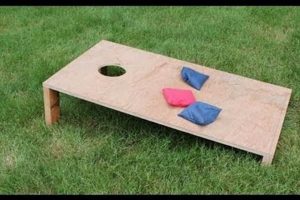A self-constructed apparatus designed to mitigate moisture absorption in 3D printing materials represents a cost-effective alternative to commercially manufactured devices. These builds typically leverage readily available components like food dehydrators, repurposed containers, and electronic control units to create a low-humidity environment conducive to preserving filament integrity. The core function is to provide a heated, enclosed space where filament spools can be stored and dried, thereby preventing issues such as stringing, warping, and poor layer adhesion during the printing process.
Maintaining optimal dryness is crucial for achieving high-quality 3D prints. Hygroscopic filaments, particularly nylon and certain polycarbonates, readily absorb moisture from the atmosphere. This absorbed moisture degrades the material, leading to compromised mechanical properties and print defects. Implementing an in-house drying solution offers a way to combat these challenges, extending the lifespan of filament and enhancing print reliability. Historically, users have devised various methods for drying filament, ranging from placing it in ovens to using desiccant-filled containers; however, purpose-built, user-assembled systems offer a more controlled and efficient solution.
The following sections will explore different design approaches, component selection criteria, and operational considerations involved in building a personal humidity-controlled filament storage and drying system. This will encompass an overview of temperature regulation methods, enclosure construction, and safety precautions necessary for effective operation.
Tips for Optimal Filament Drying
Achieving consistent and reliable 3D printing results hinges on maintaining filament dryness. The following tips outline crucial considerations for constructing and operating a self-assembled filament drying apparatus.
Tip 1: Temperature Control is Paramount: Precision in temperature regulation is critical. Excessive heat can deform or melt the filament, while insufficient heat fails to adequately remove moisture. Employ a temperature controller capable of maintaining a stable temperature within the filament’s recommended drying range, typically between 40C and 55C, depending on the material.
Tip 2: Enclosure Integrity Matters: A well-sealed enclosure minimizes moisture infiltration from the surrounding environment. Pay close attention to sealing gaps around the door or lid of the drying unit. Utilize weather stripping or similar materials to create an airtight seal, maximizing the drying efficiency.
Tip 3: Air Circulation Enhances Drying: Stagnant air hinders the removal of moisture. Incorporate a small fan within the enclosure to circulate air and facilitate even drying throughout the filament spool. Ensure the fan is rated for continuous operation at the chosen drying temperature.
Tip 4: Desiccant Usage Augments Effectiveness: Integrating desiccant packs within the drying chamber further reduces humidity levels. Silica gel is a common choice; however, consider using rechargeable desiccant canisters that can be easily refreshed by heating in an oven. Monitor the desiccant’s condition and replace or recharge it as needed.
Tip 5: Material-Specific Drying Parameters: Different filament types require varying drying times and temperatures. Consult the filament manufacturer’s recommendations for optimal drying parameters. For example, nylon requires significantly longer drying times than PLA.
Tip 6: Safety Considerations are Essential: Exercise caution when working with electrical components and heating elements. Employ proper wiring techniques and grounding to prevent electrical hazards. Ensure the drying unit is placed on a non-flammable surface and is adequately ventilated.
Tip 7: Monitor Humidity Levels: Integrating a hygrometer within the drying unit allows for real-time monitoring of humidity levels. This provides valuable feedback on the drying process and allows for adjustments to temperature or drying time as necessary.
These guidelines underscore the importance of meticulous planning and execution in constructing an effective filament drying solution. Adherence to these recommendations will contribute to improved print quality and reduced material waste.
The subsequent discussion will delve into troubleshooting common issues encountered during filament drying and offer practical solutions for optimizing performance.
1. Enclosure
The enclosure constitutes a critical component of a self-assembled filament drying apparatus. Its primary function is to establish a controlled environment that minimizes the ingress of ambient humidity, thereby facilitating effective moisture removal from the filament. The design and material composition of the enclosure directly influence the drying system’s overall efficiency. For instance, a poorly sealed enclosure allows humid air to enter, negating the effects of the heating element and desiccant. Conversely, a robust, airtight enclosure maximizes the drying potential by containing the heated, low-humidity air and preventing external moisture from rehydrating the filament. Real-world examples include the utilization of repurposed food dehydrators, airtight storage containers, or custom-built boxes constructed from materials like acrylic or plywood, each demonstrating varying degrees of effectiveness based on their sealing capabilities.
The choice of enclosure material impacts heat retention and insulation. Insulated enclosures, such as those constructed with foam board or double-walled designs, reduce energy consumption by minimizing heat loss to the surroundings. This is particularly relevant for filaments requiring higher drying temperatures or for users operating the drying system in colder environments. Furthermore, the size of the enclosure must be adequate to accommodate various spool sizes and allow for sufficient airflow around the filament. Insufficient space can lead to uneven drying and potential hot spots, compromising the integrity of the filament. A practical application involves using clear acrylic for the enclosure’s construction, enabling visual monitoring of the filament spool’s condition and the desiccant’s saturation level without disrupting the drying process.
In summary, the enclosure’s design and construction are paramount to the success of a self-assembled filament drying solution. A well-sealed, insulated enclosure minimizes moisture infiltration, optimizes heat retention, and promotes efficient drying. The challenges lie in achieving an airtight seal while maintaining ease of access for filament loading and unloading, and providing adequate ventilation without compromising the enclosure’s integrity. Addressing these challenges ensures the prolonged usability and reliability of the drying system, contributing to consistent, high-quality 3D printing outcomes.
2. Temperature Control
Temperat
ure control is a cornerstone of effective filament drying, particularly within the realm of self-assembled systems. The precision and stability of temperature regulation directly influence the efficacy of moisture removal and the preservation of filament integrity. Inadequate temperature control can lead to either insufficient drying or material degradation, both of which compromise the quality of 3D printed parts. Therefore, a detailed examination of temperature control methodologies within the context of a do-it-yourself filament dryer is essential.
- Heating Element Selection
The selection of the heating element is paramount for achieving accurate temperature regulation. Common options include ceramic heaters, incandescent bulbs, and repurposed heating elements from appliances like food dehydrators. The chosen element must provide sufficient heating capacity to raise the enclosure’s temperature to the desired level. However, it must also be controllable to prevent overheating, which can deform or melt the filament. For example, a resistive heating element with a proportional-integral-derivative (PID) controller offers a precise and stable heating solution, while an unregulated incandescent bulb may result in temperature fluctuations and potential damage.
- Temperature Sensor Placement and Calibration
The placement of the temperature sensor directly impacts the accuracy of the temperature reading within the filament drying enclosure. Ideally, the sensor should be positioned near the filament spool to provide a representative measurement of the filament’s temperature. Furthermore, the sensor should be calibrated to ensure its accuracy against a known reference. For instance, using a thermocouple positioned adjacent to the filament and calibrating it against a calibrated thermometer minimizes temperature discrepancies and ensures that the filament is dried at the intended temperature.
- Control System Implementation
The control system governs the operation of the heating element based on the temperature sensor readings. Common control system implementations include simple on-off controllers, proportional controllers, and PID controllers. PID controllers offer the most precise temperature regulation by continuously adjusting the heating element’s output based on the error between the target temperature and the measured temperature. For example, an Arduino-based PID controller can be programmed to maintain a stable temperature within +/- 1 degree Celsius, ensuring consistent drying conditions.
- Thermal Insulation and Airflow Management
Thermal insulation and airflow management play a critical role in maintaining uniform temperature distribution within the drying enclosure. Adequate insulation minimizes heat loss to the surroundings, reducing the heating element’s workload and improving energy efficiency. Airflow management, achieved through the strategic placement of fans or vents, prevents temperature stratification and ensures that all parts of the filament spool are exposed to the same drying conditions. For example, lining the enclosure with reflective insulation and incorporating a small fan to circulate air promotes even temperature distribution and minimizes the risk of hot spots.
These interconnected facets of temperature control collectively dictate the performance of a self-assembled filament drying apparatus. Each component must be carefully selected, calibrated, and integrated to achieve accurate, stable, and uniform temperature regulation. The application of precise temperature control not only enhances the drying process but also safeguards the filament from thermal damage, ultimately contributing to improved 3D printing outcomes. Effective control methods are crucial for any filament dryer.
3. Air Circulation
Within a self-constructed filament drying apparatus, air circulation serves as a critical mechanism for enhancing moisture removal and ensuring uniform drying of the filament spool. The forced movement of air within the enclosed chamber promotes the evaporation of water molecules from the filament’s surface, which is then carried away, preventing localized humidity saturation. Without adequate air circulation, pockets of high humidity form around the filament, hindering the drying process and potentially leading to uneven drying. For example, if a filament spool is placed in a static, heated environment, the outer layers may dry more quickly than the inner layers, resulting in differential stresses within the filament that could lead to warping or cracking during printing.
The effectiveness of air circulation is directly related to the positioning and power of the circulating fan. The fan’s placement should facilitate the movement of air across the entire surface of the filament spool, ensuring that no areas are left stagnant. In systems utilizing desiccant materials, airflow should also be directed across the desiccant to maximize its moisture absorption capacity. Furthermore, the fan’s power must be sufficient to overcome the resistance of the filament spool and enclosure, creating a consistent airflow pattern. Some designs incorporate multiple smaller fans strategically positioned to create a more uniform and efficient airflow distribution, thereby addressing potential dead zones within the drying chamber. The operational significance of appropriate air circulation manifests in the reduced drying time and the improved consistency of filament properties, ultimately enhancing print quality and reliability.
In summary, air circulation is not merely an ancillary feature but an integral component of a functional filament drying system. Its purpose is to accelerate moisture evaporation and ensure uniform drying across the filament spool. Challenges in implementing effective air circulation often involve balancing fan power, placement, and enclosure design to achieve optimal airflow distribution without creating excessive turbulence or localized hot spots. Proper understanding and implementation of air circulation principles are essential for realizing the full benefits of a self-assembled filament drying solution, linking directly to the overarching goal of improved 3D printing material management and print quality.
4. Desiccant
Desiccant materials are integral to the functionality of a self-assembled filament drying apparatus. Their inclusion augments the moisture-removing capabilities of the system, contributing to the overall effectiveness of preserving 3D printing filament. Proper selection and implementation of desiccant are crucial for maximizing performance.
- Mechanism of Action
Desiccants function by absorbing moisture from the surrounding environment, thereby lowering the ambient humidity within the enclosure. This reduction in humidity facilitates the evaporation of moisture from the filament, driving the drying process. A common desiccant, silica gel, contains a porous structure that attracts and holds water molecules. The effectiveness of this process is contingent on the desiccant’s surface area and its capacity to absorb moisture relative to its mass.
- Types of Desiccant Materials
Various desiccant materials exist, each exhibiting distinct properties. Silica gel, a prevalent choice, is chemically inert and capable of absorbing a significant amount of moisture. Molecular sieves offer a higher moisture absorption capacity, particularly at low humidity lev
els, but may be more expensive. Clay-based desiccants present a cost-effective alternative but typically have a lower absorption capacity compared to silica gel or molecular sieves. The selection of the desiccant should align with the filament type being dried and the desired level of dryness. - Regeneration and Replacement
Desiccant materials become saturated over time, diminishing their moisture absorption capacity. Regeneration involves removing the absorbed moisture, typically through heating, restoring the desiccant’s effectiveness. Silica gel, for instance, can be regenerated by baking it in an oven. Molecular sieves often require higher temperatures for regeneration. Alternatively, saturated desiccant can be replaced with fresh material. The frequency of regeneration or replacement depends on the humidity levels within the environment and the volume of desiccant utilized.
- Placement and Quantity
The placement of desiccant within the drying enclosure influences its efficiency. Strategically positioning the desiccant near the filament spool and ensuring adequate airflow around the desiccant maximizes its exposure to moisture. The quantity of desiccant required depends on the enclosure’s volume and the expected humidity levels. An insufficient amount of desiccant may result in incomplete drying, while an excessive amount may be unnecessary. Optimization of desiccant placement and quantity is crucial for achieving efficient moisture removal.
Desiccant use is directly linked to the effectiveness of a self-assembled filament drying solution. Its implementation must be coupled with appropriate enclosure design, temperature control, and air circulation to ensure comprehensive moisture removal. Proper management of desiccant materials, including regeneration or replacement, is essential for maintaining the system’s long-term performance, particularly when drying filaments with high moisture sensitivity.
5. Filament Compatibility
Filament compatibility is a critical consideration when designing and utilizing a self-assembled filament drying apparatus. Different filament types exhibit varying sensitivities to temperature and humidity, necessitating a system capable of accommodating these diverse requirements to prevent material degradation or ineffective drying. The design parameters of the drying system, therefore, must be carefully aligned with the intended range of filament materials.
- Temperature Sensitivity
Different filament types have distinct glass transition temperatures and optimal drying temperatures. Polycarbonate, for example, requires significantly higher drying temperatures compared to polylactic acid (PLA). A self-assembled drying system must incorporate a temperature control mechanism capable of accurately maintaining the specified temperature range for each filament type. Failure to do so may result in either inadequate drying for high-temperature filaments or thermal damage to low-temperature filaments.
- Spool Size Accommodation
Filament spools are manufactured in various sizes and dimensions. A universal drying system should be designed to accommodate a wide range of spool sizes, ensuring that the filament can be dried without physical constraints. This may involve incorporating adjustable spool holders or designing the enclosure with sufficient internal dimensions to accommodate larger spools. Limited space can create uneven drying, rendering the device only partially effective.
- Material Hygroscopy
The hygroscopic nature of a filament dictates its susceptibility to moisture absorption. Nylon, for instance, is highly hygroscopic and requires a more robust drying system compared to less hygroscopic materials like polypropylene. The drying system’s design should consider the desiccant capacity, airflow, and temperature control necessary to effectively remove moisture from highly hygroscopic filaments. A system optimized for PLA may be inadequate for drying nylon effectively.
- Enclosure Material Compatibility
The materials used in the construction of the drying enclosure should be compatible with the temperature range and humidity levels generated during operation. Certain plastics, for example, may release volatile organic compounds (VOCs) at elevated temperatures, which could contaminate the filament and affect print quality. The enclosure material should also be resistant to degradation from prolonged exposure to heat and humidity. Food-safe materials are often preferred to avoid potential contamination issues.
The interplay between these factors underscores the importance of tailoring the self-assembled filament drying apparatus to the specific requirements of the intended filament materials. A generalized approach may compromise the drying effectiveness or even damage the filament. A comprehensive understanding of filament properties and the associated design considerations is essential for achieving optimal drying performance and ensuring consistent 3D printing results.
6. Safety
The construction and operation of a self-assembled filament drying apparatus inherently involve potential safety hazards that must be addressed to prevent injury or damage. The utilization of electrical components, heating elements, and enclosed spaces necessitates a rigorous adherence to established safety protocols. Failure to incorporate adequate safety measures can result in electrical shock, burns, fire hazards, or exposure to potentially harmful fumes. For instance, improper wiring of the heating element can lead to short circuits and potential ignition of surrounding materials, while inadequate ventilation can result in the build-up of VOCs emitted from certain filaments during heating.
A crucial aspect of safety within these systems is electrical grounding. Ensuring that all metallic components are properly grounded mitigates the risk of electrical shock in the event of a fault. Additionally, the selection of appropriate fuses or circuit breakers protects against overcurrent situations that could lead to overheating and fire. Temperature control systems must incorporate fail-safe mechanisms to prevent uncontrolled temperature increases. For example, a high-temperature limit switch can automatically disconnect the heating element if the temperature exceeds a pre-set threshold. Furthermore, the enclosure material must be non-flammable or flame-retardant to minimize the risk of fire propagation. Clear labeling of electrical components and hazard warnings further enhances safety awareness.
In summary, safety is not an optional add-on but an indispensable element of a self-assembled filament drying solution. A proactive approach to hazard identification and mitigation is paramount for ensuring safe operation. Challenges often arise from the complexity of integrating electrical components, thermal management, and material selection. Addressing these challenges through careful planning, adherence to safety standards, and the implementation of appropriate safeguards is essential for mitigating risks and promoting responsible construction practices.
Frequently Asked Questions
The following addresses common inquiries regarding the construction and operation of user-created filament drying systems.
Question 1: What is the optimal drying temperature for hygroscopic filaments such as nylon?
R
ecommended drying temperatures for nylon typically range from 70C to 80C. Consult the filament manufacturer’s specifications for precise guidelines. Exceeding the recommended temperature may induce material degradation.
Question 2: How often should the desiccant be regenerated within a DIY filament dryer?
The regeneration frequency depends on ambient humidity and the desiccant material. Silica gel, a common desiccant, should be regenerated when it reaches saturation, indicated by a color change (if using indicating silica gel) or a noticeable decrease in drying effectiveness. This may range from weekly to monthly.
Question 3: Is forced air circulation essential for effective filament drying?
Forced air circulation enhances drying efficiency by promoting even heat distribution and facilitating moisture removal. Stagnant air can create localized humidity pockets, hindering the drying process.
Question 4: What safety precautions should be observed when constructing a self-assembled filament dryer?
Safety precautions include ensuring proper electrical grounding, using a temperature controller with a fail-safe mechanism, and selecting non-flammable enclosure materials. Additionally, adequate ventilation is necessary to prevent the buildup of volatile organic compounds.
Question 5: Can a standard food dehydrator be repurposed as a filament dryer?
Certain food dehydrators can be repurposed, provided they offer sufficient temperature control and can accommodate filament spools. Modifications may be necessary to ensure adequate airflow and spool compatibility.
Question 6: What are the signs of insufficiently dried filament?
Signs of insufficiently dried filament include stringing, bubbling, poor layer adhesion, and a popping or hissing sound during printing. These issues typically indicate the presence of excessive moisture within the filament.
Accurate temperature control, sufficient air circulation, and the appropriate use of desiccant are vital for effective drying. Consistent monitoring and maintenance are necessary to guarantee long-term reliability.
The subsequent section will provide a comparative analysis of different design implementations for user-built drying systems.
Conclusion
The preceding discussion examined various facets of a diy filament dryer, encompassing design considerations, component selection, and operational parameters. It highlighted the significance of temperature control, air circulation, and desiccant utilization in achieving effective moisture removal from 3D printing filaments. Furthermore, safety protocols were emphasized as essential elements in the construction and operation of such apparatuses.
Constructing an effective drying system necessitates a comprehensive understanding of material properties, electrical safety, and thermal management principles. The information presented serves as a foundation for informed decision-making in the pursuit of consistent, high-quality 3D printing results. Continued diligence in monitoring performance and adherence to best practices will ensure the long-term viability and reliability of user-assembled filament drying solutions.







